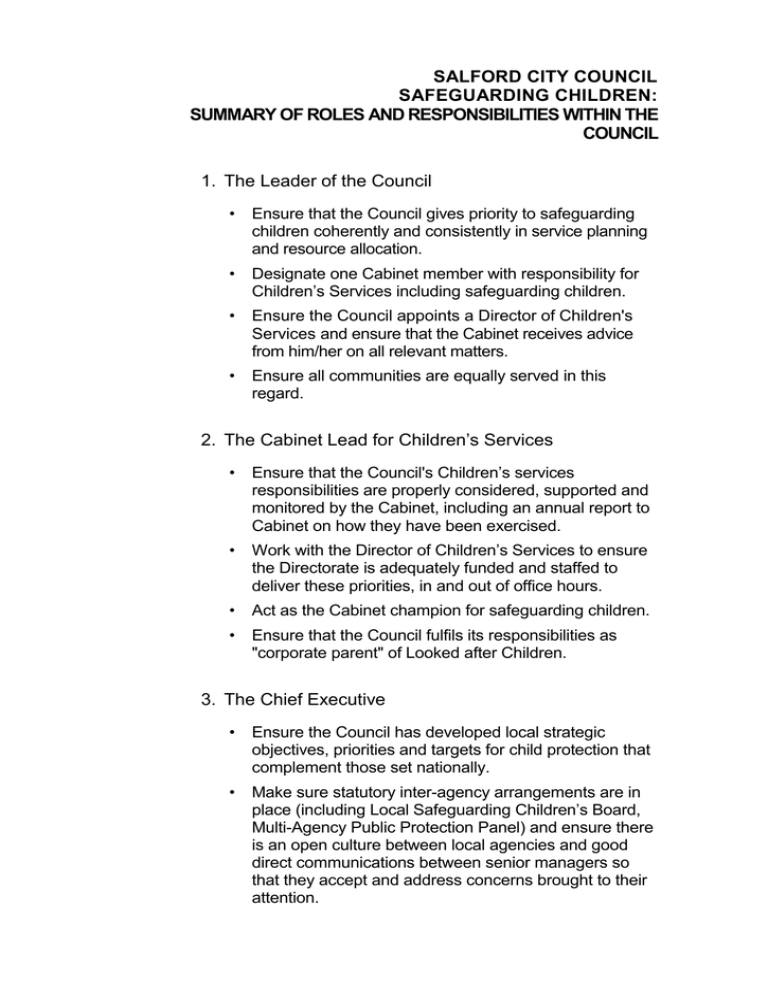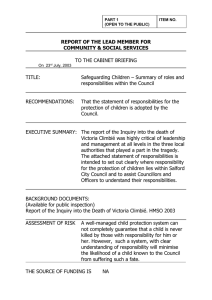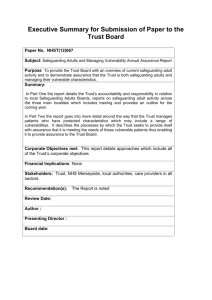SALFORD CITY COUNCIL SAFEGUARDING CHILDREN: SUMMARY OF ROLES AND RESPONSIBILITIES WITHIN THE COUNCIL
advertisement

SALFORD CITY COUNCIL SAFEGUARDING CHILDREN: SUMMARY OF ROLES AND RESPONSIBILITIES WITHIN THE COUNCIL 1. The Leader of the Council • Ensure that the Council gives priority to safeguarding children coherently and consistently in service planning and resource allocation. • Designate one Cabinet member with responsibility for Children’s Services including safeguarding children. • Ensure the Council appoints a Director of Children's Services and ensure that the Cabinet receives advice from him/her on all relevant matters. • Ensure all communities are equally served in this regard. 2. The Cabinet Lead for Children’s Services • Ensure that the Council's Children’s services responsibilities are properly considered, supported and monitored by the Cabinet, including an annual report to Cabinet on how they have been exercised. • Work with the Director of Children’s Services to ensure the Directorate is adequately funded and staffed to deliver these priorities, in and out of office hours. • Act as the Cabinet champion for safeguarding children. • Ensure that the Council fulfils its responsibilities as "corporate parent" of Looked after Children. 3. The Chief Executive • Ensure the Council has developed local strategic objectives, priorities and targets for child protection that complement those set nationally. • Make sure statutory inter-agency arrangements are in place (including Local Safeguarding Children’s Board, Multi-Agency Public Protection Panel) and ensure there is an open culture between local agencies and good direct communications between senior managers so that they accept and address concerns brought to their attention. • Receive regular briefings that identify the strengths and weaknesses of the Council's services and on the action required to address them. • Ensure all children's services are sensitive to diversity. 4. The Director of Children’s Services • Ensure that the Directorate has management and accountability structures that deliver safe and effective services, with particular reference to the Children Acts of 1989 and 2004 and Working Together to Safeguard Children. • Ensure that the Directorate has access to a range of effective, efficient and flexible services that protect and support vulnerable children and their families. • Ensure effective multi-agency planning processes are in place to plan for children in need and that there is an effective Local Safeguarding Children Board that coordinates services and ensures that children are protected in all settings including hospitals. • Ensure the effective management and use of the Child Protection Register by relevant agencies. • Ensure that those with framework, scrutiny and delivery arrangements have appropriate training to enable them to exercise the responsibilities of their role. • Ensure staff are well trained, supported and managed, and feel able to report any concerns. • Ensure children in need are listened to, both in service provision, and at a more strategic level. • Ensure the safeguarding of children in all educational provision, whether pre-school day care, primary, secondary or residential schools, or out of school activities, youth work, play, childcare and family learning. • Make sure all schools, educational, cultural, sports and leisure services have policies and procedures for child protection. • Ensure measures are in place to promote good attendance; to manage behaviour and tackle bullying and other forms of harassment; to provide effective personal, social and health education; and support for family learning, opportunities for personal and social development, and support for the voice of young people and children. • Specific attention should be given to groups at risk of low achievement, including children in the public care, with special needs, and particular ethnic groups; the attendance, behaviour and provision for pupils out of school, within the context of a general approach to educational inclusion. • Ensure that maintained schools, staff and governors and other direct educational provision and cultural, sports and leisure services are fully integrated in, and familiar with, child protection procedures. 5. The Director of Community, Health & Social Care • Ensure the safeguarding of children in all sports, cultural and leisure provision irrespective of the age of the child or setting. • Ensure that staff delivering social care services to adults are watchful for any child protection issues in families they are dealing with. 6. The Director of Customer & Support Services • Ensure expert legal advice is available to the Council on its child care responsibilities. • Ensure that robust arrangements are in place for pre and post recruitment checks to be undertaken for all appropriate people working with children in the Council and the services it arranges and funds. 7. All Directors and Heads of Service • Should be committed to safeguarding children and should communicate that commitment throughout the organisation. • Ensure their services are provided in a way that ensures the safety of all children. • Ensure all staff in services with contact with children and/or their parents have a consistent understanding of the thresholds for sharing information with and referral to Social Care & Health/ Police, and receive appropriate training to undertake their responsibilities to safeguard and promote the welfare of children. 9. Scrutiny Committee Members • Take all necessary steps to scrutinise the Council's arrangements for safeguarding children, with particular reference to: • the adequacy of funding • staff levels and morale • the Children’s Services Directorate's performance, including unallocated cases • the care, education, health and achievements of Looked After Children • that protection is accessible to all communities. 10. Members’ Children’s Services Panel • Cabinet Lead is responsible for bringing matters raised by the Panel to the Director and Cabinet's attention. • Fulfil councillors' responsibilities to visit children's homes. • Responsible for providing Elected Members to all other children’s social services functions including Permanence and Fostering Panels , Rota Visit Review Panel and Quality Review Panel. 11. All Councillors • Should be aware of how and when to refer child welfare concerns to Social Care and Health/Police and how, after the referral has been registered, that there are subsequent constraints on staff sharing information as set out in the Council's Political Conventions. • Should be aware of their responsibilities as "corporate parents" of Looked after Children. 12. Local Safeguarding Children Board. The inter-agency group with responsibility for agreeing how the different services and professional groups should co-operate to safeguard children in Salford, and for making sure that arrangements work effectively to bring about good outcomes for children. • Responsible for ensuring the inter-agency accountabilities of the Local Authority and other agencies identified in section 13 of the Children Act 2004 are fulfilled. 13. Assistant Directors with responsibility for children’s services • Ensure that children are protected, and they and their families benefit from effective referral, assessment, planning and review processes, which result in appropriate services being provided to respond to the identified developmental needs of the child. • Maintain positive and constructive relationships through the LSCB with partner agencies. • Ensure that staff are provided with up-to-date procedures, protocols and guidance and that systems are in place to ensure they are followed. • Ensure arrangements are in place for the safe transfer of responsibility between local authorities. • Ensure clarity in the role of child protection advisers. • Ensure induction, supervision and staff development processes are in place. • Ensure performance measures are in place to ensure services, including those commissioned from external organisations are safely, efficiently and cost-effectively delivered. • Ensure workload management systems are in place and monitored. • Ensure staff are able to offer culturally appropriate services to all the communities of the city. 14. Principal and Service Managers • Ensure effective systems are in place to enable team managers to establish how many children have been referred to their team, what action is required to be taken for each child, who is responsible for taking action, and when that action must be completed and has been completed. • Ensure that all cases of children assessed as needing a service have an allocated worker. • Ensure that staff follow procedures, protocols and guidance and that casework is checked regularly. • Report to Assistant Directors on the quality and performance of their services, including workloads, on a regular basis through supervision. • Ensure that all unallocated work is regularly reviewed to ensure children at serious risk are not left unallocated 15. Team Managers • Ensure that referrals are acknowledged. • Ensure that cases are allocated to appropriately qualified and trained practitioners and that the practitioner is clear about what has been allocated, what action is required, and how that action will be reviewed and supervised. • Ensuring and monitoring that core Directorate standards for recording and managing case files are met. • Ensure the quality of work and supervision. • Ensure practitioners are able to manage the diversity aspects of their work. 16. Child Care Practitioners • Follow the Council's child protection procedures. • Maintain records of their work. • Keep up to date through training and other professional development opportunities. 17. Other Practitioners and Support Staff • Pass all concerns about child protection to the appropriate Children and Families Social Work Team without delay.





